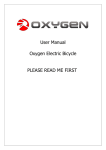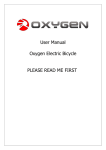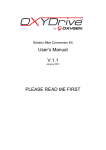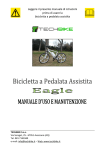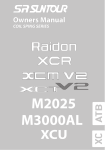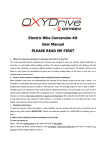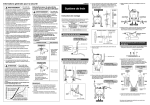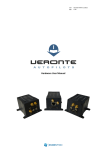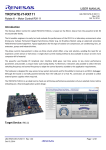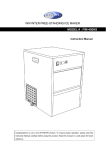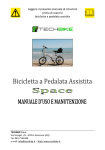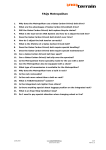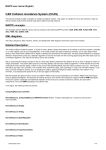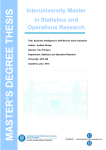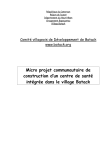Download PLEASE READ ME FIRST
Transcript
User’s Manual Operation and Maintenance Instructions Oxygen E-mate PLEASE READ ME FIRST 2nd Edition – April 2010 Oxygen E-mate – Table of Contents Page number 1. Introduction 3 2. About Oxygen E-mate and its design 4 3. The first ride 4 3.1 Preparation of bicycle for riding 4 3.2 Safety checks before first ride 7 3.3 The law requirements 8 3.4 Your own safety 8 3.5 Carrying the luggage on your bike 9 4. Regular use and basic checks 10 5. Lubrication of the bike components 11 6. Battery care and re-charging process 12 6.1 Battery charging 12 6.2 Battery care and maintenance 12 7. Regular self maintenance 13 6.1 Fitting the front wheel 14 8. Technical specification and performance 18 9. Getting maximum range from the battery 19 2 1. Introduction Dear customer, Thank you for choosing the Oxygen Electric Bicycle – smart move ;-) We at Oxygen believe that by making this purchase decision you are going to change your life and the way you move around. We hope that the impact the bicycle is going to have on you will bring you loads of joy and satisfaction. By using your bicycle regularly you will also have your impact on reduction of carbon footprint and saving our environment. If you would have any questions or comments about our product please do not hesitate to contact us. We warmly welcome any kinds of comments and suggestions including those negative ones. At Oxygen we aim at 100% customer satisfaction treating all kinds of comments and suggestions very seriously. Now it is important to read these few short notes and make sure you use your bicycle according to the below instructions. We promise won’t be long but it’s al for your safety. Oxygen Bicycles 3 2. About Oxygen E-mate and its design Oxygen E-mate electric bicycle is a two wheeled bicycle designed with the thought of commuting and travelling on a longer distances. Its frame geometry combines all three in one types of riding position. At Oxygen we call it SCT geometry standing for Sport City Touring. SCT riding position has been set up to be the most optimal and ergonomic for your power performance as well as your health condition. This makes new E-mate so comfortable and efficient on the long distances. The bicycle can be used for commuting and moving around the city. The bicycle can also be used on the public roads as well as on off road pathways. What the bicycle is not designed for: Please do not use the bicycle in extreme conditions such as jumps and on the extreme downhill tracks. The bicycle frame is not designed for the following applications: Extreme Cross Country XC, Dual DS, 4X Four Cross, Free Ride FR, and Downhill DH The maximum allowable payload for the bicycle is: 120kg for the rider 15kg of the luggage located on the rear rack 3. The First Ride This chapter concentrates on setting up your bicycle before the first ride including your riding position, safety checks and the aspect of your legal issues. 3.1 Preparing the bicycle before the first ride 3.1.1 It is highly important to pay attention to the first set up of your new bicycle before the first ride. For us at Oxygen the customer is put first and this part concentrates on your health and the proper set up of your bicycle. Before you actually have your first ride it is crucial to set you up and your riding position that is why this point concentrates on setting you up and your position on the bicycle. Set up of the seat (saddle) height on your bicycle. It is important that your bike seat (saddle) is at the correct height to ensure that your bike ride is comfortable, healthy for your knees and just as importantly, to conserve energy while you pedal. A. Please place yourself while seating on the bike against the wall of post. B. By holding your brake seat on the saddle and put your heel on the pedal. Your leg should be almost straight but your knee should be very little bent. 4 C. Please see the pictures and see to get idea of what is correct and what is not. 5 While adjusting the seat height please note that each seat post has the safety marking on the seat pillar. Please do not exceed the border of safety in any circumstances. The markings on the seat pillar always need to be hidden in the seat tube and never exposed above it. Seat post adjusted above its acceptable limits may cause the personal injury as well as the damage to the frame. 3.1.2 Familiarising yourself with the brake system Before you set up for the first ride it is crucial to familiarise yourself with the brake system. Please remember while seating on the bicycle the RIGHT HAND LEVER operates the front brake and the LEFT HAND LEVER operates the rear brake. When you use the brakes it is best practice to use both brakes at the same time. When you ride the bicycle in the wet conditions it is important to estimate that the braking performance may be poorer than on the dry surface. Always include extra distance for braking during wet conditions. 6 3.2 Safety checks before the first ride 3.2.1 Check the tyres pressure. All tyres have a recommended tyre pressures which should be used on the bicycle. For tyres fitted on all Oxygen Bicycles the pressure should be set between 35-60psi. It is however advisable to keep a higher pressure on the tyres in the region of 55psi as this reduces the likelihood of getting the puncture on your tyres. It is also important not to pump the tyres more than maximum recommended pressure. This may affect your comfort of riding the bike as well increases the risk of rim damage and tyre explosion. Please note that keeping the bike in the bright sun may also increase the pressure in the tyres therefore it is recommended to keep a pressure at slightly lower level during the hot summer days. 3.2.2 Charge the battery for the first time The battery should be fully charged before the first time for at least 10 hours. The charger has an automatic charge cut off protection and even if it shows the full charge has been made please allow the battery to condition for the few more hours. The first few charge and discharge cycles should be deep and full. It means the battery should be run down to nearly maximum and the same the charging process should never been interrupted until the battery is fully charged. To fully condition your battery please allows three to four full charges / discharge cycles. For battery charging please see the P4 of this manual. 3.2.3 Check the handle bar and stem assembly. Before having your first ride make sure that all the stem and handle bar assembly bolts have been securely tight up. In order to check those please try to move handle bars up and down and same on the side from the left to the right. All the Oxygen Bicycles should be sold and prepared to ride by the authorised dealers however Oxygen Bicycles can not guarantee all those procedures have been completed, particularly in the case of online sales. It is therefore crucial to check all those components before the first ride. 7 3.2.4 Check your brakes Your brakes are one of the most important parts of your bike. These should always be in a fully working condition and checked not only before the first ride but every time before you are to ride your bike. Please note you should never ride your bike with none or even only one working brake. Both brakes should be always in the fully working condition at all times. 3.2.5 Importance of keeping seat posts suspension cover. Each Oxygen E-mate is equipped with suspension seat post. The moving parts of the post are covered with the rubber protection. It is important to check the condition of rubber and the position of fitment. It is particularly important when carrying the baby on the rear racks saddle to prevent the pinching of fingers in the post. 3.3 The law requirements It is important that the bicycle is equipped in the appropriate safety components such as bell and the legal lighting system. Please remember to use the full lighting system whenever the bicycle is ridden the dark conditions. Please note that we do not recommend using the flashing lighting systems. This type of lighting may not be legal to use on the public roads. The appropriate lights colours in majority of countries worldwide correspond to WHITE for the front light and RED for the rear. Please note that the green colour for the front light is illegal in the European Union countries and should never be installed on the bicycle’s handlebar in any of the EU countries. 3.4 Your own safety This last point of preparing before the first ride covers your own safety. RULE no.1 we at Oxygen always recommend using bicycle helmets in any circumstances whenever you ride your bicycle. Please use the cycle helmet at all times regardless of the time or distance of your ride. RULE no.2 there is another aspect of safety. Please never ride the bicycle under the influence of alcohol or drugs. Riding the bike under influence of any of the above significantly increases the risk of an accident, serious injury or even death. 8 3.5 Carrying the luggage on your bike 3.5.1 Attaching your luggage It is important to make sure that the luggage attached on to bike is attached securely and within the maximum limit. Please make sure you only use the appropriate pannier sets for your luggage needs. Each pannier should be attached to the carrier on the carrier’s railings. 3.5.2 Maximum allowable luggage Please make sure that your total allowable luggage on the rear carrier does not exceed 15kgs including your panniers sets. The luggage should be placed equally on both sides by maximum of 7.5kgs on each side of the carrier. 3.5.3 Warnings for the use of luggage carrier: It is important that the luggage is placed equally on both sides of the rack without significant differences in weight. Please do not over load the rear carrier with the more than the maximum allowable weight. Please do not attach the child seat to the standard rear rack supplied. Please be aware that for the child seat you should use specifically designed carrier The luggage can not be modified by the user in any case. This may have a negative impact on the rider’s safety and any sorts of modifications are not permitted. Please check the fasteners on the rear carrier are properly fitted and regularly checked. The carrier bolds should be tightened with 2.5nm torque. The luggage carrier supplied with the bike is not designed to pull the trailer. Please do not pull the trailer with this luggage carrier. Please note that the bicycle when fully loaded may behave differently in terms of steering and braking performance. Please take a note of that when riding the fully loaded bicycle. Please make sure there is no loose straps coming out of the panniers which could be caught by the rotating spokes in the wheel. Please make sure that the luggage fitted on the carrier does not obstruct the visibility of the lights fitted to the carrier. 9 4. Regular use and bike maintenance It is very important to highlight that the bicycle used regularly might need the routine maintenance from time to time. In order to ensure the maximum safety on your bike we strongly recommend carrying a routine maintenance checks described in the paragraph no.2 before each ride. Additionally once a month we would like to point out that it is very useful to carry the following checks: - - - - - Spokes – These should be checked after 300 miles (approx 500km) after the bike purchase. Additionally it is a very good practice to check those every 500 miles (800km) and make sure that all of those are not getting loosed. Brake pads – On the average every 500 miles it recommended to check the condition of your brake pads. The life time of brake pads may vary very significantly and may last as much as 5000 miles or as little as 250 miles. It all depends on the conditions the bike is being used. In the rain and muddy conditions the brake pads are likely to last a lot less then in the dry conditions. The ridden terrain also might have a impact on the pads lifetime. In the hilly mountain area the pads are likely to worn out quicker than in the flat area where a lot less braking is applied. Running gears – Running gears have a significant impact on the comfort of riding. The quickly shifting gears work a lot better and make a lot less noise. Tyres condition – Never ride the bike with the worn out tyres. These are more likely to have puncture as well as more importantly have a lot less safety. The new tyre performs a lot better in every condition. Chain – Remember to clean and lubricate your chain from time to time. Please note that the clean lubricated chain will last a lot longer. To lubricate the chain use only the lubricants sold by the bike shops. Do not use engine oil or grease to lubricate your chain. Please contact directly contact directly to the dealer for any lubricants action on your bike. Rims Condition – If the bicycle is using the rim V-brake type brakes it is important to check the condition of the rim from time to time. The rims run under regular usage of brakes and the rims wall thickness is reducing. Significantly used rim may explode under high tyre pressure. As as result this can cause an accident, serious injury or even death. It is however difficult to check the condition of the rim for inexperienced users therefore we do recommend to the visit the local bicycle shop and ask for the professional advice on the rims condition. Most of the bike shops offer the free advice on the rims conditions. Please do not neglect this issue and check your rims regularly with the professional service centre. Warning: As all mechanical components the bicycle is subjected to wear and high stresses. Different material and components may react to wear and stress fatigue in different ways. If the design life of the component has been exceeded, it may suddenly fail causing injuries to the rider. Any forms of crack, scratches or colour change in the high stressed areas indicate the life of the component has been reached and it should be replaced. 10 5. Lubrication of the bike components Every time you ride your bicycle its condition changes. The more you ride the more regular maintenance will be required on the bike. We recommend you spend a little time on the regular maintenance checks. Below table is just a guide on how often to carry on the regular maintenance tasks. Frequency Weekly Monthly Every six months Annually Component Lubricant How to lubricate Chain Derailleur wheels Derailleurs Brake levers Brake callipers Chain Lube or light oil Chain Lube or light oil Oil Oil Oil Brush on or o squirt Brush on or o squirt 2 drops from oil can 2 drops from oil can 2 drops from oil can Freewheel Brake cables Shift levers Pedals Derailleur cables Wheel bearings Headset Oil Lithium Lithium Lithium Lithium Lithium Lithium 2 squirts from oil can Disassemble Disassemble Disassemble Disassemble Disassemble Disassemble based based based based based based grease grease grease grease grease grease NOTES: Please note that the above table is just the example on what kind of lubricants to use and their frequency. Please never use the spray degreasers for lubrication. Always contact your bike dealer for the best advice on what type of lubricant to use. If you feel uncomfortable with carrying on the routine maintenance please use one of the bicycle service centres 11 6. Battery care and re-charging process 6.1 Battery charging It is important to follow these few steps before the first charge. Firstly the battery has to be fully charged before the first use. In order to do it please take a chargers rounded plug and plug it in to the battery’s socket. Next take chargers mains plug and plug it in to the electricity socket. It is important to follow the order of this procedure and not to plug the charger’s mains plug first and then the small rounded one to the battery. The full charging cycle should take as long as the green light appears on the chargers. Please not that while the red light appears on the charger the battery is still in the charging process and the battery should not be disconnected from the charger until the green light appears. 6.2 Battery care and maintenance If the battery has been totally discharged it important to charge it the same day as the discharge has been done. Once you finish the ride please allow approx 10-20 minutes before plugging the battery in to charge. The battery needs a cooling off period of couple of minutes before it will be recharged again. Please note that if the bicycle is not used for longer period of time then the battery should be charged before. Batteries stored for longer period of time should be charged for approx 2 hours every 2 months. The lithium ion batteries have a self discharging process if not in use therefore these have to be recharged every certain period of time. The failure in doing so may result on battery loosing its voltage and eventual damage to the battery. IMPORTANT: Never try to open the battery case. The battery case can be open only by authorised and trained service centre appointed by Oxygen Bicycles. Unlawful breach of this rule will automatically invalidate the battery warranty. The unlawful maintenance to the battery may also cause a serious injury or even death. Oxygen Bicycles is not responsible for any sorts of accidents and damages caused by the unlawful battery maintenance. 12 7. Regular self maintenance - Oxygen Bicycles allows a certain parts of bicycle to be maintained by the owner. We do however recommend that any sorts of maintenance and bike care are made by the qualified cycle mechanic. The parts that are allowed to be self maintained by the owner are: A. Brakes. For full manual on how to set up the Bengal Performance brakes please visit the following web link: http://www.bengalperformance.com.tw/download.html and click at the appropriate language version of the mechanical brakes maintenance and set up. For full manual on how to set up the V-brakes please visit the following web link: http://techdocs.shimano.com/media/techdocs/content/cycle/SI/BrakeSystem/BR-M431M421/8DV0A-BR-M431_M421-EN_v1_m56577569830604303.pdf B Running gears For adjustment manual on how to set up the running gears please refer to the Shimano technical documents available here: http://techdocs.shimano.com/media/techdocs/content/cycle/SI/Tourney/RearDerailleur/SI5V80A-En_v1_m56577569830612967.pdf Please note that Oxygen Bicycles does not allow for any sorts of self maintenance to the electrical components. Torque recommendations Rear axle nuts Seat pillar clamp nut/bolt Brake cable anchor bolt Brake centre bolt M6: Gear shifter nuts V brake caliper nuts Rear carrier nuts Mudguard bracket nuts Other M4 M5 M6 33N.m 5-8N.m 5N.m 11N.m 4N.m 10N.m 8N.m 8N.m nuts torque depends on the size: 2.5-4N.m 4-6N.m 6-7.5N.m 13 7.1 Fitting the front wheel and Quick Release set up From time to time there is a need of removing the front wheel from the forks. It is however important to know how to set up the front wheel back being securely fitted in the forks. 14 What to look at during the front wheel fitment!!! The lever should be tight up properly to the end of its travel. It might occur that the lever is too soft during locking. In that case the please hold the locking nut on the other end of the axle and by turning lever around you can set up to the required level. 15 Please note what the correct and incorrect set up of the front axle 16 17 8. Technical specification and performance Motor 250W high efficiency brushless Suzhou Bafang 8FUN 36V 26” Battery Advanced Lithium Polymer 36V 13Ah Modes On / off switch and off road from handle bars, throttle and peddle assisted Assisted Range 13Ah Up to 60 miles (96km) Range throttle only 13Ah Up to 30 miles (48km) Total weight 13Ah 23.65kg inc. battery Maximum speed 15.5mph (25kph) to conform to EU directives power automatically cuts off at 25kph Gears Shimano Tournay derailleur with 7 speed Shimano mega range 14-16-18-2022-24-28T Forks Suspension SR Suntour Brakes Rear; alloy V-brake calliper. Front; Bengal Performance Disc Brake Saddle post Alloy with hinged seat for easy battery change Chain wheel Alloy Pro-wheel 52 teeth Pedals Bright alloy non-slip Spokes 13g Stainless steel Rims 26" x 1.5 Alex Rims Chain Shimano CN UG51 Tyres Kenda 26*1.95 18 9. Getting maximum range from the battery The range and performance of your battery depends on the number of different factors affecting its performance. How to maximise your battery range: A. Check your tyres pressure. Its best to keep a tyres pressure in the region of 55-60 PSI. With the low tyre pressure there is a higher rolling resistance. With the higher pressure you will have a lot lower rolling resistance and the bike will be smoother to ride. B. Carry the minimum extra luggage if possible. Then less weight you carry then the longer the range of the bicycle will be. C. Try to assist whenever possible. Then more your own effort you will put into pedalling them longer the range will be. The overall range is however influenced by the number of other factors on which the rider may not always have an influence. The range quoted in the technical specification is based on the riding the bicycle with pedal assist mode on the flat terrain only and with the rider’s weight not exceeding 80kg in total. Please note that for those of the greater weight the range may be considerably lower than quoted. In the hilly terrain the range will also decrease as there is more being consumed during the climbing. The battery also gets the best performance in the average temperature of 20-25C. Then lower the temperature outside then lower the range will be. Dear user, if there is still anything that you are not sure about your electric bicycle please do not hesitate to contact us either through our website www.oxygenbicycles.com or by sending us direct email to [email protected] 19



















